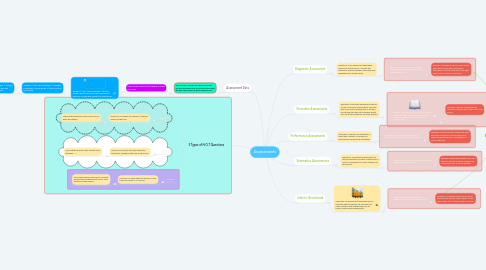
1. Formative Assessments
1.1. Definition: Formative assessments can be formal or informal assessments. The main goal of formative assessment is student monitoring through out the whole lesson, and consistent feedback from the teacher.
1.1.1. Example: Have the students do a quick write summary in their journal at the end of the lesson writing about three things they learned today.
1.1.1.1. Example: Have the students do an interactive Kahoot quiz at the end of the lesson.
2. Summative Assessments
2.1. Definition: Summative assessments are used to evaluate a student at the end of a unit by comparing it to some standard or benchmark.
2.1.1. Example: Give the students a midterm with multiple choice questions.
2.1.1.1. Example: Having the students do a final project. Such as creating a poster and PowerPoint over a natural disaster.
3. Performance Assessments
3.1. Definition: Students are expected to show their mastery of content by performing or producing something.
3.1.1. Example: An example of performance assessment would be making a portfolio.
3.1.1.1. Example: Students create a questioner over interview questions to ask someone who lived through World War II and interview a person who has.
4. Interim- Benchmark
4.1. Definition: An assessment educators use to evaluate where students are compared to other students and whether they are on track to pass future assignments.
4.1.1. Example: An example would be a benchmark test given to the students.
4.1.1.1. Example: An example would be an end of course exam given to the students to see where they are at the end of the semester.
5. Diagnostic Assessment
5.1. Definition: Is an assessment that takes place prior to the lesson. It allows the teacher to see the students strengths and weakness prior to the lesson.
5.1.1. Example: Have a unit pre-test for the students over information that will be covered in the unit.
5.1.1.1. Example: Have the students create a KWL chart prior to the lesson and have a discussion over their responses and what their schema to the content area.
6. 3 Types of H.O.T Questions
6.1. Opening
6.1.1. What do you predict will happen in the text based off the title?
6.1.1.1. When writing what are some ways we can hook the reader?
6.2. Guiding
6.2.1. Why do you believe the main character wanted to change by the end of the novel?
6.2.1.1. How might the food chain change if you removed... ?
6.3. Closing
6.3.1. How will you take what we learned in class today and apply it to real life?
6.3.1.1. How would explain this topic to another person who has never heard of it? How would you teach them?
7. Assessment Data
7.1. The teacher analyzes the data and comes up with strategies and accommodations that will help the student achieve academically.
7.1.1. Three students who are struggling and their RTI scores
7.1.1.1. Student 1 (155): Two Strategies: 1) let the student have base ten blocks in his desk 2) work one on one with student on regrouping
7.1.1.1.1. Student 2 (179): Two Strategies: 1) student be placed in a small group 2) active monitor be in place

